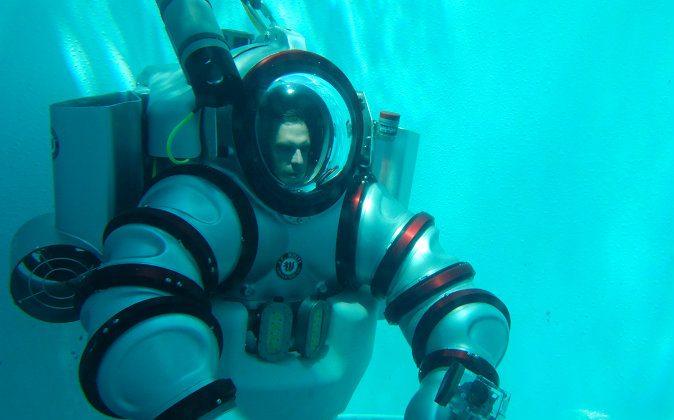It recalls the clunky, old divers’ suits worn by the pioneers of underwater exploration. The Exosuit is a cutting-edge tool, however, perhaps representing a turning point in deep-sea exploration.
The Exosuit unveiled this week will allow divers to reach 1,000 feet under the sea, where the pressure is more than 30 times the surface pressure, and where a little-understood world of marine life awaits further discovery and exploration.
Originally designed as a construction device for performing underwater repairs, the Exosuit enables divers to stay in deep waters for prolonged periods time while allowing them the dexterity and maneuverability to perform delicate tasks.
As a scientific tool, it will be used to sample and image diverse biological entities with high-resolution underwater cameras in areas difficult to reach. Wearing the suit, a scientist can work at great depths for up to three to five hours. A non-suited diver would only be able to stay at the same depth for a couple of minutes. In case of an emergency, the suit’s oxygen system provides up to 50 hours of life support.
The Exosuit resembles a metal space suit: It stands 6.5 feet tall and is made out of aluminum alloy. It weighs about 500 to 600 pounds on land, but can navigate effortlessly under water.
It has 18 rotary joints filled with oil that provide flexibility so the pilot can examine and collect specimens. It has special manipulators that serve as hands. The pilot can use a manipulator to handle and collect delicate marine animals without damaging them. The Exosuit is the only such suit in existence.
Accompanying the suit is a remotely operated vehicle, the DeepReef-ROV, that can house up to 10 cameras. The ROV will be used to take high-resolution images of marine animals in their natural habitat. As long as someone is operating it from the surface, the vehicle can stay underwater for days. Previously, scientist mostly studied deep waters using ROV with cameras that provided limited views of the animals.
The suit was developed and constructed by Canadian company Nuytco Research Ltd. over a period of 15 years and it will continue to be modified for scientific needs. It has a price tag of $600,000. With the ROV, the set costs about $1.2 million.
This summer, the Exosuit will be dispatched for the first time on the Steph J. Barlow Bluewater expedition. A group of researchers and dive experts will use the Exosuit to explore an underwater area called “The Canyons” 100 miles off the New England coast. This area has waters that are more than 10,000 feet deep. There, project coordinator Michael Lombardi will dive to depths up to 1,000 feet to study bioluminescent animals, or animals who generate visible light through a chemical reaction.
“Our access to these deeper open-water and reef habitats has been limited, which has restricted our ability to investigate the behavior and flashing patterns of bioluminescent organisms, or to effectively collect fishes and invertebrates from deep reefs,” stated John Sparks, a curator in the American Museum of Natural History’s Department of Ichthyology, in a press release. “The Exosuit could get us one step closer to achieving those goals.”
The Exosuit will be on display at the American Museum of Natural History in New York City until March 5.
New Exosuit Opens Up Deep-Water Exploration Like Never Before
It recalls the clunky, old divers’ suits worn by the pioneers of underwater exploration, but the Exosuit is a cutting-edge tool that could represent a turning point in deep-sea exploration.

By Yi Yang
2/28/2014
Updated: 2/28/2014




Friends Read Free